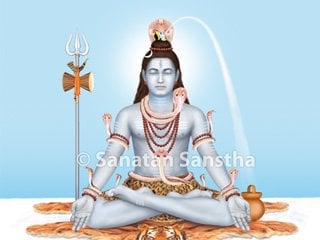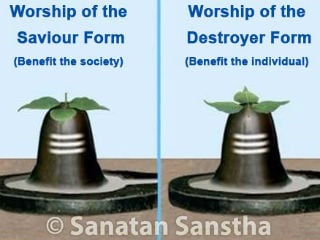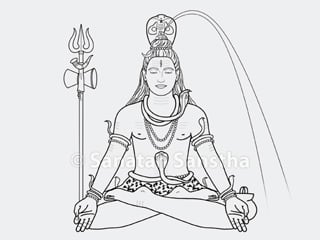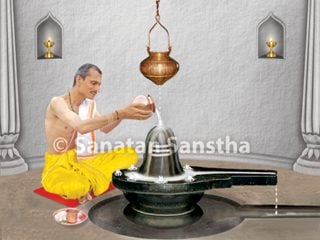
God Shiva
Contents
2. Origin & Definition of God Shiva’s Principle
3. Physical attributes of God Shiva
One of the most important attributes of a good devotee is constant spiritual curiosity about the Deity he wishes to worship. Related information will help the devotee gradually enhance faith in the Deity, and intensify spiritual practice. Often, devotees rely on wrong sources of information, such as TV series, films or even novels written on Deities.
Introduction
The following article will help devotees of God Shiva get scripturally accurate and authoritative information about the meaning of God Shiva’s Principle, His physical attributes and His family. We pray that this knowledge assists devotees in creating a firm foundation for effective spiritual practice, so that they can obtain the Divine grace of God Shiva.
Origin & Definition of God Shiva’s Principle
1. The word Shiva (शिव) has been derived by reversing the letters of the word ‘vash’ (वश्). Vash means to enlighten; hence, the one who enlightens is Shiva. Shiva is Absolute, self-radiant. He remains radiant and illuminates the universe.
2. Shiva is an auspicious and prosperity-bestowing Principle.
3. Shiva means Brahman and Paramshiva means Supreme Brahman
Physical attributes of God Shiva
The appearance of God Shiva has profound spiritual meaning and significance. Let us gain some insight so that we can interpret the knowledge in it.
God Shiva’s colour
The colour of God Shiva is white. It is difficult for seekers to tolerate the intense vibrations of God Shiva’s original white colour. Hence, Shiva’s body is enveloped with ash colour.
Ganga
Let us understand some definitions of the word Ganga in short
1. गमयति भगवत्पदमिति गङ्गा ।, that is, गङ्गा (Ganga) means the one who elevates (the bathing person) to the state of God.
2. गम्यते प्राप्यते मोक्षार्थिभिरिति गङ्गा । – Shabdakalpadrum, meaning, the one, to who those desirous of Liberation turn, is Ganga.
Ganga on Earth
The Holy River Ganga has its origin at Gangotri in the Himalayas. It has a small percentage of the subtle Principle of the spiritual Ganga. Hence, however impure it might become due to pollution of its water, it always remains Holy.
Moon
Shiva adorns the Chandra (Moon) on His forehead. The moon is a stage with the combined existence of qualities of affection, compassion and maternal love.
Third Eye
1. The vertical eye on Shiva’s forehead and in the subtle form, just above the midpoint of the eyebrows is considered to be His Third Eye. It is also the greatest seat of extrasensory energy and has been named as Jyotirmath, Vyaspeetha etc.
2. Shiva’s third eye is a symbol of the Absolute Fire Principle. Even in Shiva’s picture His third eye has the shape of a flame.
3. Shiva has eliminated carnal desire with His third eye. (A truly knowledgeable individual burns all his desires with the flame of his knowledge.)
4. According to the Yogshastra third eye means the central channel of the Kundalini (or the Sushumna Nadi).
5. Shankar is three-eyed, which means He can perceive events in the past, present and future.
Naga (Serpent)
1. The naga (Serpent) is also considered to be Shiva’s weapon. The nine serpents in the universe are also referred to as ‘Navanarayan’. The Navanathas have originated from these nine serpents.
2. The serpent is a representation of the Purushtattva (God Principle). He is the Deity that bestows progeny.
Bhasma
God Shiva has applied bhasma (Holy ash) all over His body. Bhasma is also referred to as God Shiva’s Semen.
Rudraksha
God Shiva adorns chains of rudraksha beads around the knotted hair on His head and around the neck, arms, wrists and waist.
Vyaghrambar
व्याघ्र or Tiger (denoting the Raja and Tama components) is a symbol of cruelty. Shiva killed such a tiger (the Raja-Tama) and made a vyaghrambar (Seat) from its skin.
God Shiva’s Family
Every Deity has a family comprising other Deities and many other beings from the subtle world. This section is an eye-opener on God Shiva’s family.
Consort
Shri Parvatidevi (Information on Parvati and Her forms is provided in Sanatan’s Holy text – Shakti.)
Sons
1. Shri Kartikeya
‘He is the son of Shiva and Parvati. He is named Kartikeya because He was nurtured and brought up by Deities of the constellation of six stars known as Krutikas.’
2. Shri Ganapati
For more information on Shri Ganapati, please click here, ‘Shri Ganapati’
3. Others
Many infant Deities such as Murugan, Shvasta, Shasta, Skanda, Atavi, Atavishvar, Avalokiteshvar, Avaloki, Kotaputra etc. later merged into Shiva.
Shivagan (Attendants of God Shiva)
Attendants of God Shiva reside in Shivaloka (Shiva’s abode) and are His servitors. Nandi, Shrungi, Bhugiriti, Shaila, Gokarna, Ghantakarna, Veerabhadra and Mahavikata are considered to be the main groups of attendants. The different types of Shiva’s attendants are as follows.
1. Ugraganas
They undertake spiritual practice of the form of Shankar known as Ugreshwar.
2. Rudragnas
Rudra means one who cries. They cry, yearning for a vision of God.
3. Bhutganas and Pishachaganas
The functions and spiritual practice of each of the above three types of attendants are different. Some attendants come to Shiva from Yama’s abode, while others approach Him through Nandi, the bull, as a medium. The colour and the organs of each of the attendants are different.
4. Shivadoot (Messengers of Shiva)
Short, stocky with a reddish complexion and two tusks, the duty of these Shivadoots is to transport the souls of expired devotees of Shiva in the pushpak viman (Flying chariot) to Kailas, the abode of Shiva.
5. Nandi (Vehicle)
Nandi in the form of a bull is Shiva’s vehicle, and occupies an important position in Shiva’s family. Nandi is paid obeisance to before paying obeisance to Shiva.

 Unique Spiritual experiences of Miss Smital Bhujle after chanting Om Namah Shivay
Unique Spiritual experiences of Miss Smital Bhujle after chanting Om Namah Shivay How to celebrate Mahashivaratri during adverse times?
How to celebrate Mahashivaratri during adverse times? Spiritual science underlying the ritual of offering a bel (aegle marmelos) leaf to Deity Shiva
Spiritual science underlying the ritual of offering a bel (aegle marmelos) leaf to Deity Shiva Spiritual characteristics of Deity Shiva
Spiritual characteristics of Deity Shiva What is the significance of consecrating the Shivapindi with milk on Mahashivratri?
What is the significance of consecrating the Shivapindi with milk on Mahashivratri? How to take darshan of Shiv pindi ?
How to take darshan of Shiv pindi ?